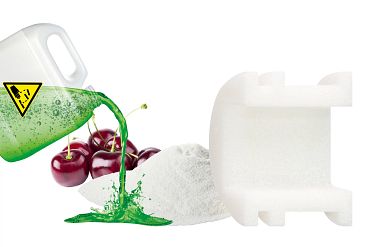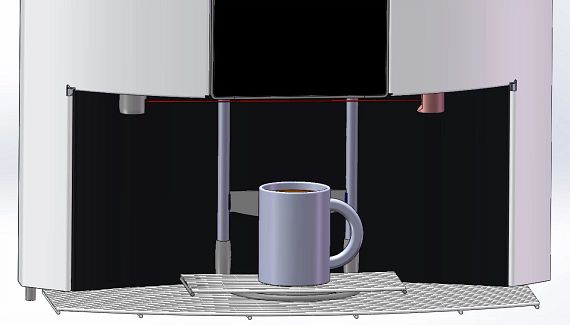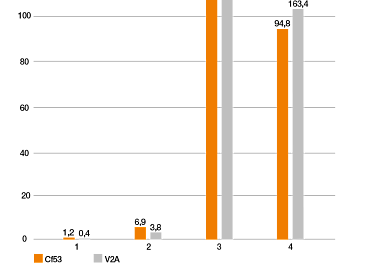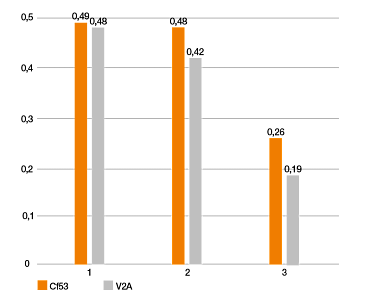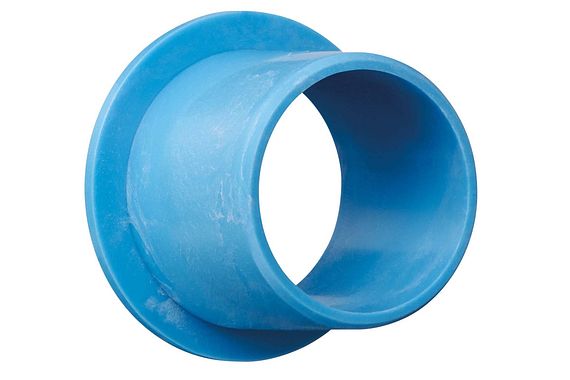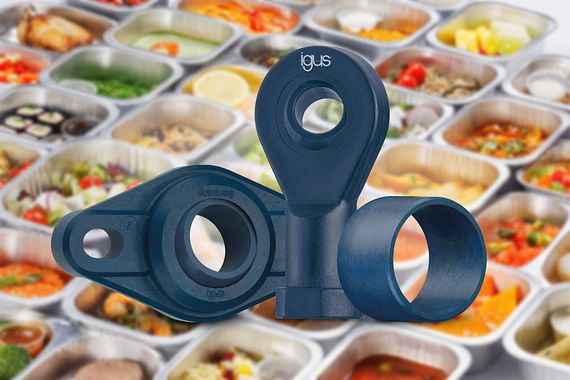내마모성 부품을 위한 식품 안전 3D 프린팅
► Food-safe in accordance with the requirements of the FDA and/or EU directive 10/2011
► Up to 50 times more abrasion-resistant than commonly used 3D printing plastics: Ideal for moving parts
► No lubrication needed thanks to integrated solid lubricants
► Individual plastic parts ready to ship within 24 hours
Upload 3D model as STEP file and get prices without any commitment to buy
► Upload doesn't work? Click here to start the upload directly in the 3D printing service tool.
Load sample model and test the online 3D printing service
3D 프린팅 서비스로 내마모성 부품 주문 또는 직접 프린팅
iglidur I6 레이저 소결

- Printed parts are compliant with the FDA and EU 10/2011 food-specific regulations
- Max. application temperature: +80°C
- Extremely abrasion-resistant: e.g. at least 9 times more abrasion-resistant
than PA12 (SLS) in rotation test - Best strength and surfaces of all igus food-safe 3D printing materials
iglidur I6에 대한 추가 정보
iglidur I150: 범용 필라멘트

- Printed parts are compliant with the EU 10/2011 food-specific regulations
- Can be processed on all regular 3D printers
- The most frequently used tribo-filament® with very good mechanical specifications (strength, resilience, layer adhesion)
iglidur I150에 대한 추가 정보
iglidur I151: 육안으로 검출 가능
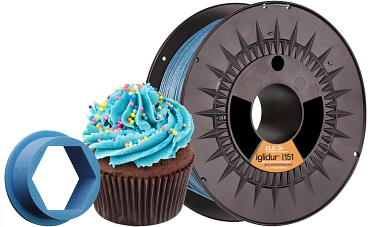
- Compliant with food-specific regulations according to EU 10/2011 and the FDA
- Blue colour for optical detectability
- Can be processed on all commercial printers
- Printed in the 3D printing service within three days
iglidur I151에 대한 추가 정보
내열성: iglidur A350

- EU 10/2011 및 FAD의 식품 전용 규정 준수.
- 최대 180°C의 온도 내성, UL94-V0에 따른 난연성
- 스팀 멸균 적합 재질
- 고온 3D 프린터 필요
iglidur A350에 대한 추가 정보
식품 전용 규정 준수를 위한 레이저 소결
iglidur I6
레이저 소결 재질 iglidur I6은 FDA 및 EU 10/2011의 식품 전용 규정을 준수하므로 식품 및 음료 산업의 많은 어플리케이션에서 사용 가능합니다. SLS 방식으로 인해, 특수 부품, 프로토타입 및 대량 부품을 이구스 3D 프린팅 서비스를 통해 3일 내에 1-10,000개 생산할 수 있습니다. 이구스에서 가공하고 식품 전용 규정을 준수하는 모든 3D 프린팅 재료 중에서 iglidur I6이 가장 많이 선택됩니다. 이는 강도가 크고, 표면이 우수하고, 구성품 가격이 낮기 때문입니다.iglidur I6의 구성품 재질로 인해 고성능 폴리머는 특히 위생적일 뿐만 아니라 슬라이딩 능력도 우수합니다. 따라서 특히 낮은 수준의 마찰이 요구되는 웜 휠과 같은 어플리케이션에서 자주 요구됩니다. SLS 파우더는 이구스의 3D 프린팅 재료 샵에서 구입하여 모든 일반 레이저 소결 장비에서 가공할 수 있습니다.
iglidur I6 재질 데이터 시트 및 FDA 적합성 선언(pdf)
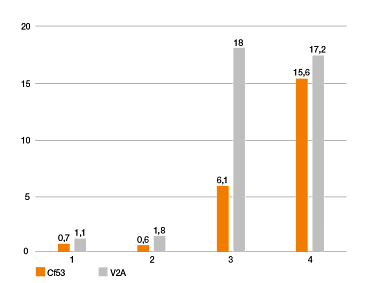
iglidur I6 적용 사례
완전 자동 커피 머신에 들어가는 자동 컵 트레이 조정
완전 자동 커피 머신의 컵 트레이 높이 조정을 자동화하기 위해 기계 공학 학교 Ansbach의 프로젝트 팀은 센서와 모터 구동 메커니즘을 개발했습니다. 필요한 부품인 샤프트 끝단 지지대와 스핀들은. 이 목적을 위해 특별히 제작된 마찰 최적화 폴리머 iglidur I6을 사용한 선택적 레이저 소결로 생산되었습니다. 우수한 작동 특성 외에도 고성능 폴리머는 FDA 및 EU 102011에 따른 식품 규정 준수로 연구팀을 설득할 수 있었습니다.
3D 프린팅 기계 구성품 알아보기
시중에서 판매되는 3D 프린터로 식품 안전 부품 제조
iglidur I150
iglidur I150은 가공하기 가장 쉬운 트리보 필라멘트입니다. 구입 가능한 모든 3D 프린터에 적합하며, PLA 및 PETG와 같은 일반 필라멘트처럼 쉽게 가공할 수 있습니다. iglidur I150은 EU 10/2011 적합성으로 인해 식품 접촉에 적합하며 그에 따라 식품 및 포장 산업 어플리케이션에서 스스로를 입증하고 있습니다. 유일한 제한 사항은 최대 영구 어플리케이션 온도가 65°C이며 매우 동적인 어플리케이션에 적합하다는 것입니다. iglidur I150은 8kg 필라멘트 릴에서도 사용할 수 있으므로 대형 프린터에서 대형 구성품을 제조하는 데 적합합니다.구입 가능한 iglidur I150
iglidur I150 material data sheet and approval for use with food (PDF)
식품 안전, 육안 검출 가능한 필라멘트
iglidur I151
The iglidur I151 tribofilament was specifically developed for the food and packaging industries. The printed parts are compliant with FDA and EU directive 10/2011 food regulations. The standard industry blue colour ensures the required visual detectability, since no natural food is blue. Its good mechanical properties (strength, toughness, layer adhesion) makes iglidur I151 an all-rounder material that is suitable for most applications and 3D printers. It can be processed just as easily as standard PLA and PETG filaments. iglidur I151 has mechanical properties comparable to those of iglidur I150. Like all other tribofilaments, it contains solid lubricants, allowing low-maintenance, hygienic dry operation. iglidur I151's high wear resistance extends the service life of parts printed from it so that it is up to 50 times that of parts made of ABS, PETG, or PLA. Learn what's important for 3D printing with food-grade filament in our blog.구입 가능한 iglidur I151
iglidur I151 declaration of FDA compliance (PDF)
내열성 및 식품 안전
iglidur A350
내마모성 고온 트리보 필라멘트 iglidur A350은 식품 및 포장 산업용으로 특별히 개발되었습니다. 원료는 EU 10/2011 및 FDA 식품 접촉 규정을 준수하며, 검출 가능성을 위해 항상 파란색입니다. iglidur A350으로 제작된 프린팅 부품은 최대 180°C의 온도 내성이며, UL94-V0에 따라 난연성이고, 뜨거운 증기로 멸균도 가능합니다. 340-360°C의 높은 가공 온도와 최소 160°C의 필수 빌드 챔버 온도로 인해, 가공하는 데 고온 3D 프린터가 필요합니다. 이러한 프린터를 사용할 수 없는 경우, iglidur A350으로 제작된 내마모성 부품을 이구스 3D 프린팅 서비스를 통해 신속하고 저렴하게 제조할 수 있습니다.온라인 샵에서 구입 가능한 iglidur A350
iglidur A350 material data sheet (PDF)
Chemical-resistant, food-compliant parts printed in three to five days
iglidur I10
iglidur I10, the new laser-sintering powder, allows fast manufacture of chemical-resistant parts that are food-compliant. It is especially well-suited to machinery for the food and electroplating industries. Rapid production with laser sintering means that abrasion-resistant, lubrication-free special parts can be manufactured to drawing within a few days. Since the 3D printing service involves neither tool costs nor minimum order quantities, manufacture of chemical-resistant parts is economical with no minimum quantity (10,000 units maximum).Details on iglidur I10 in the shop
iglidur I10 declaration of FDA compliance (PDF)
식품 접촉 추가 솔루션
식품 안전 가이드 롤러
예를 들어, 나이프 엣지 롤러는 컨베이어 벨트에서 가이드 롤러로 사용됩니다. FDA 승인을 받아 식품 산업에 적합한 나이프 엣지 롤러는 iglidur A250 재질로 제작되었습니다.
식품 안전 나이프 엣지 롤러에 대해 자세히 알아보기
식품 접촉용 플랜지 포함 슬리브 베어링
iglidur A181 재질은 FDA 규정을 준수하며 10/2011 EU에 적합합니다. 파란색은 식품 산업에서 간혹 요구되는 '시각적 탐지 기능'을 한층 강화시켜 줍니다. iglidur A181로 제작된 플레인 베어링은 플랜지가 있거나 없는 상태로 제공됩니다.
식품 안전 플랜지형 부싱에 대해 자세히 알아보기
식품 접촉을 위한 저마찰 라이너
트리보 테이프 라이너는 머신 베드 내에서 이동을 최적화하기 위해 마찰학적으로 까다로운 다양한 표면과 형태의 범용 라이닝용으로 설계되었습니다. 0.5-1mm(접착 후면 0.15mm 포함)의 두께에서는 매우 작은 공간이 필요합니다. 테이프는 가위로 간단히 자를 수 있고, 옵션 자가 접착 라이너 테이프는 그 용도가 거의 무궁무진합니다. 라이너는 FDA 요구사항에 따라 식품에 안전합니다.
식품 안전 라이너에 대해 자세히 알아보기
위생 설계 지침에 따라 개발된 에너지체인
청소가 간편한 케이블용 TH3 에너지체인은 FDA를 준수하며, 식품 산업에서 사용되는 플라스틱 요소의 일반적인 색상인 파란색입니다. 특히 강력한 세제 및 화학물질에 대한 내성이 높아 식품 및 음료 산업에서 사용하기에 이상적입니다.
식품 접촉 플라스틱 추가 솔루션
모든 가공 단계에서 식품 위생 및 식품 안전을 위한 엄격한 요구사항을 준수하기 위해 이구스는 식품 가공 기계 및 장비를 위한 광범위한 폴리머 솔루션을 공급합니다. 이구스는 다양한 종류의 베어링, 에너지체인, 케이블, 직동 가이드, 리드 스크류 가이드뿐만 아니라 스톡 바 및 공구 없이 특수 부품을 제작하는 3D 프린팅을 공급합니다. 이구스의 기계 구성품은 이동 어플리케이션용으로 특별히 개발되었으며 윤활이 필요하지 않기 때문에 제품 오염이 전혀 없습니다.
식품 산업용 이구스 솔루션에 대해 자세히 알아보기
3D 프린팅 마모 테스트
iglidur® 폴리머는 PLA, ABS, 기타 재질 및 제조 프로세스 대비 내마모성이 우수합니다3D 프린팅
산업용 내마모성 고성능 폴리머. 고형 윤활제로 뛰어난 내마모성과 긴 사용 수명. 식품 접촉, ESD 보호, 내열성 등을 위한 특수 폴리머.3D 프린팅 폴리머 더 알아보기
FAQ on 3D printing with food-grade plastics
What does food grade mean in relation to plastics?
It means that the material coming into contact with food has been tested for a possible transfer of particles of the plastic to the food, whereby a defined limit value has not been exceeded. On the European market, the requirements for plastics to achieve food conformity are regulated by EU Regulation 10/2011, in the U.S. by the FDA (U.S. Food & Drug Administration).
How can you tell if a material is really food safe?
If a material meets the requirements for food conformity according to the EU standard 10/2011 or the specifications of the FDA (U.S. Food & Drug Administration), it is confirmed by a declaration of conformity. The specifications for the use of the respective substance are noted there.
If a material meets the requirements for food conformity according to the EU standard 10/2011 or the specifications of the FDA (U.S. Food & Drug Administration), it is confirmed by a declaration of conformity. The specifications for the use of the respective substance are noted there.
Do you need a special 3D printer to produce food-safe components?
Before and during printing, the food-grade material must be protected from dust. We therefore recommend an enclosed installation space.
Before and during printing, the food-grade material must be protected from dust. We therefore recommend an enclosed installation space.
Do you need to specifically clean the printer before printing with food grade materials?
Basically, all parts that come into contact with the filament should be free of residues. This applies in particular to the extruder sprocket and the pressure nozzle. In addition, a clean print bed is imperative. The glass plate should be cleaned and the use of either no adhesive or a food grade adhesive is recommended.
Basically, all parts that come into contact with the filament should be free of residues. This applies in particular to the extruder sprocket and the pressure nozzle. In addition, a clean print bed is imperative. The glass plate should be cleaned and the use of either no adhesive or a food grade adhesive is recommended.
What must you pay attention to in the print settings?
The settings should be chosen in the slicing software so that the surface of the object is as dense as possible. Among other things, this is achieved by lowering the printing speed and adapting the line width to the nozzle diameter. This allows unevenness in the component surface and reduces gaps in the cover layers.
The settings should be chosen in the slicing software so that the surface of the object is as dense as possible. Among other things, this is achieved by lowering the printing speed and adapting the line width to the nozzle diameter. This allows unevenness in the component surface and reduces gaps in the cover layers.
Can I also achieve food safety for the component with 2 materials in multi-material printing?
It is not recommended to produce food compliant components in multi-material printing together with other, non-food grade materials, as mixing of the materials cannot be completely ruled out. The support material should either be food grade or the same material should be used as support material.
It is not recommended to produce food compliant components in multi-material printing together with other, non-food grade materials, as mixing of the materials cannot be completely ruled out. The support material should either be food grade or the same material should be used as support material.
Can a printed component that complies with food regulations come into permanent contact with food?
If there is prolonged contact between the plastic component and food, this increases the chance of migration of plastic particles. Therefore, it is important to check the food compliance declaration for the maximum permitted contact time. It may vary depending on whether the FDA or EU 10/2011 declaration is considered.
The ambient temperature of the application also plays a role. The higher the temperatures, the shorter the contact should be. Parts made of iglidur I6 are suitable for a maximum 2-hour contact with food at temperatures of up to 70°C (according to EU regulation 10/2011).
If there is prolonged contact between the plastic component and food, this increases the chance of migration of plastic particles. Therefore, it is important to check the food compliance declaration for the maximum permitted contact time. It may vary depending on whether the FDA or EU 10/2011 declaration is considered.
The ambient temperature of the application also plays a role. The higher the temperatures, the shorter the contact should be. Parts made of iglidur I6 are suitable for a maximum 2-hour contact with food at temperatures of up to 70°C (according to EU regulation 10/2011).
Do 3D-printed parts need to be additionally coated with a food-safe coating?
Components printed with food-compatible iglidur materials have a food-safe surface, so that no additional coating is necessary. It applies to the 3D printing materials iglidur I6, iglidur I150, iglidur I151 and iglidur A350.
Components printed with food-compatible iglidur materials have a food-safe surface, so that no additional coating is necessary. It applies to the 3D printing materials iglidur I6, iglidur I150, iglidur I151 and iglidur A350.
Are printed machine parts automatically food-safe if food-grade material is used for printing?
No, you only achieve food conformity by combining it with a clean 3D printing process. It is important to use clean print nozzles when 3D printing food-safe components, for example. In addition, either no adhesive (glue) or a food-grade adhesive should be used.
No, you only achieve food conformity by combining it with a clean 3D printing process. It is important to use clean print nozzles when 3D printing food-safe components, for example. In addition, either no adhesive (glue) or a food-grade adhesive should be used.
